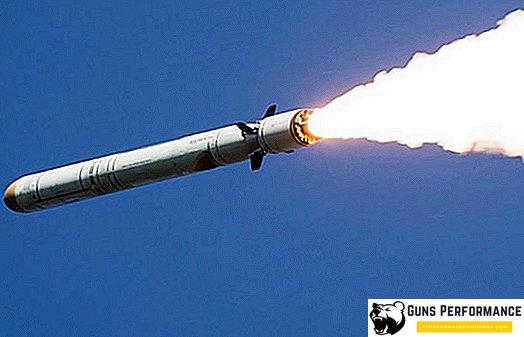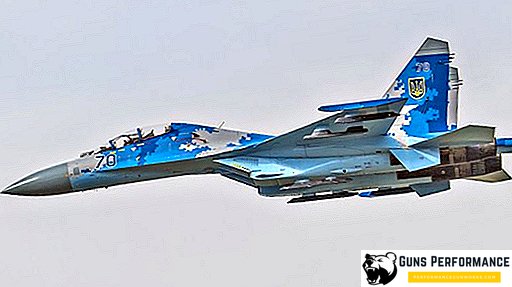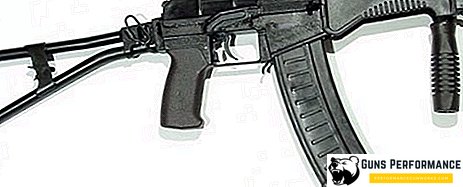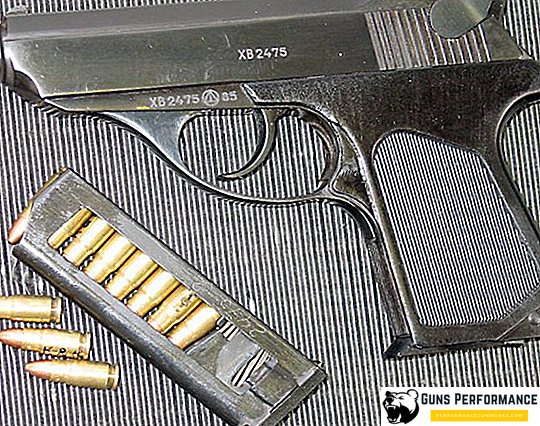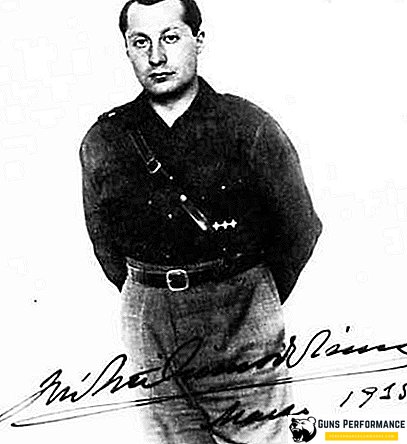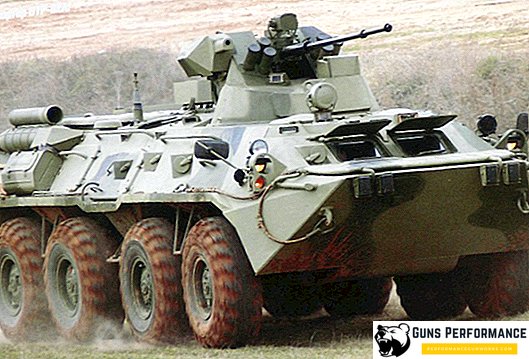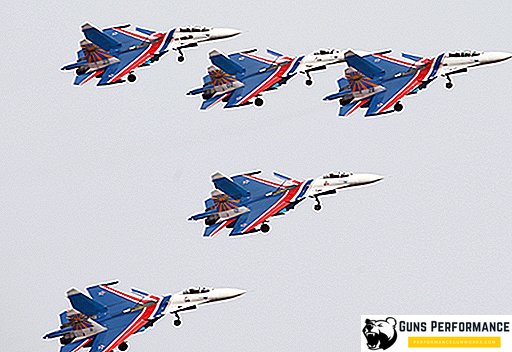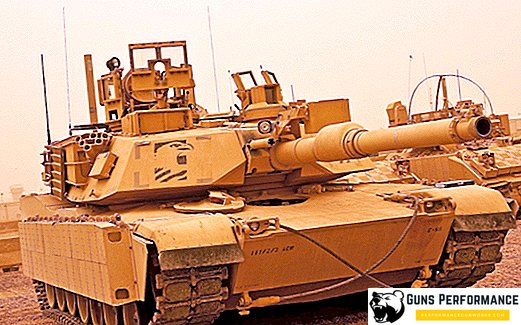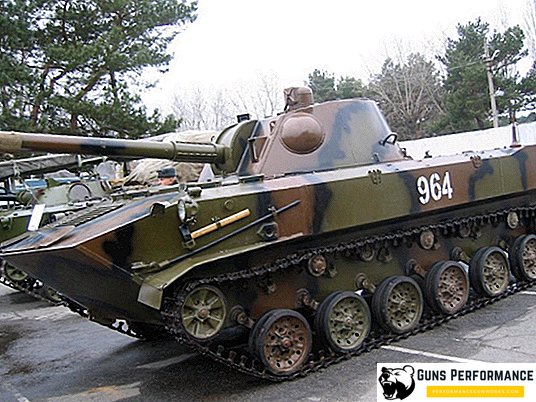
For most of its history, the Soviet Union had the strongest airborne troops in the world. This was a real elite of the armed forces, and the country's leadership took their equipment and weapons very seriously. The Airborne Forces planned to use as one of the main instruments of a preventive strike against the West. The paratroopers showed themselves well during the suppression of the Prague uprising in 1968 and in 1979 in Afghanistan.
The Airborne Forces were staffed not only with the most selective human material, but also were armed with special types of military equipment. Serious offensive operations in the rear of the enemy (this is how they planned to use the airborne forces in the event of a global conflict with NATO) demanded serious combat power, which, of course, could not be provided by BMD and small arms. The Airborne Forces required self-propelled artillery installations that could be parachuted along with paratroopers.
Work on a similar artillery system began in the mid 60s. During this period, the paratroopers received new An-8 and An-12 aircraft, capable of taking more overall and heavy loads on board.
The development of a self-propelled unit for "winged infantry" lasted more than ten years, its result was the appearance of the CAO 2S9 "Nona" - a unique self-propelled artillery gun, which still has no analogues in the world. Gun 2S9 able to perform the work of howitzers, guns and mortars.
The SAO 2S9 Nona is still used today by the Russian armed forces, and it is also in service with several other armies in the world. Since the beginning of the mass production of "Nona", 1,432 units (including the 2S9-1 modifications) of this self-propelled gun were released. Today, 750 vehicles are in service with the Airborne Forces of the Russian Federation (500 are in conservation), 30 self-propelled guns are used by the marines, and some more of the CAO are in service with the Russian border troops.
"Nona" took part in several armed conflicts and showed itself perfectly. The car has gone through several upgrades, the last of which was carried out in 2003. Despite its considerable age, "Nona" and today has no analogues in the world. The latest modifications of this self-propelled gun are equipped with modern systems of fire control, satellite navigation and communications.

History of creation
According to the Soviet military doctrine of the 50-60s, it was airborne troops that were supposed to be used for an offensive after a nuclear missile and bomb strikes on the enemy. But the airborne forces of the USSR at that time differed little from the airborne divisions and corps of the times of the war and needed to be reorganized.
The firepower of the paratroopers was also insufficient, they were armed with self-propelled guns ASU-57 and ASU-85, whose main task was to fight against enemy tanks. In addition, these installations could only be landed by landing method, which completely excluded the factor of surprise.
Another reason for the beginning of the development of a new artillery system for paratroopers was the emergence of new military transport aircraft with greater payloads: the An-8 and An-12. Therefore, in 1964, research began on the characteristics of new types of military equipment for the airborne troops. Among them were artillery installations. It turned out that the maximum mass of the combat vehicle should not exceed ten tons, together with the means of landing. In addition, the military demanded that the new car be maneuverable and have protection against weapons of mass destruction. There was nothing like the armament of the Soviet ground forces - the ACS needed to be created from scratch.
In the mid-60s, work began on the 122-mm self-propelled artillery installation "Violet" on the basis of BMD-1 and self-propelled mortar "Lily of the valley." Also for the Airborne Forces designed several light tanks armed with a 100-mm cannon. However, all of the above projects had serious flaws, so they were never put into service. For example, the chassis BMD-1 simply could not withstand the impact of a powerful 122-mm gun.
At about the same time, the BTR-D landing armored personnel carrier was commissioned. His running gear was one roller longer than the BMD-1, which allowed it to withstand more serious loads. It was the BTR-D that became the basis for the new artillery system. They decided to equip the new SAU with a unique 120-mm rifled tool, which appeared as a result of the joint work of designers from the Central Research Institute of Precision Engineering and Plant No. 172 specialists ("Motovilikha Plants").
New CAO was named 2S9 "Nona-S". The first prototype was created in 1976, and in 1980, military troop testing began. They were recognized as successful and in the same year the CAO 2S9 "Nona" was put into service.
The serial production of the self-propelled unit was deployed at the Motovilikhinsky plants and lasted until 1989. Back in 1979, the first division was formed from experimental machines. In 1985, the first modernization of the "Nona" was carried out, the new modification was called the 2S9-1 "Waxworm".
In 2003, another modernization was carried out, the new self-propelled unit received an index of 2S9-1M. She received a new automatic OMS, a satellite navigation system, as well as a system that allows each None to conduct semi-automatic fire in the division.

Description of self-propelled guns
Self-propelled gun 2S9 "Nona" has a body welded from sheets of aluminum armor. In general, it resembles the design of an armored personnel carrier BTR-D and protects the crew from small arms fire.
The front part of the machine is occupied by the department of management, in the center of which the seat of the driver is located; For each of them are provided hatches in the roof of the hull.
In the middle part of the "Nona" is the fighting compartment, with a 120-mm gun 2A51, installed in the tower on the roof of the hull. Also it is located ammunition and space for the gunner and loader. In the horizontal plane, the 2S9 can turn in the range of angles from −35 to +35 degrees.
In the stern of "Nona" is the power compartment.
120mm rifled gun 2S9 is the main "highlight" of this artillery installation. It can serve as howitzers, guns and mortars. The length of the barrel is 24.2 caliber, copy-type shutter with plastic obturator powder gases, which simultaneously performs the functions of rammer. The presence of the rammer greatly simplifies the work of the loader, especially during the "mortar" shots.
"Nona" can be used to solve various problems. The weapon is able to fight with tanks and other armored vehicles of the enemy, to destroy its defensive fortifications and manpower. Such versatility is a consequence of a wide range of ammunition that can be used by the 2S9 gun.
The CJSC "Nona" can fire 120-mm shells and mortar mines. The main type of ammunition for this artillery system is high-explosive fragmentation projectiles 3OF49. The maximum firing range of these ammunition is 8.855 km. The projectile can be installed conventional contact fuse or radio fuse. Also, the gun can use active-missiles 3ОФ51. Such a projectile has a jet engine, which increases the firing range to 12.8 km. Various types of fuses can also be installed on this type of ammunition.
For the 2A51 gun, adjustable Kitolov-2 projectiles were designed to destroy enemy armored vehicles, their artillery batteries, shelters, and also enemy manpower. The probability of hitting a target when shooting corrected ammunition is 0.8-0.9. The advantage of the Kitolov-2 projectiles is that they can hit the enemy’s equipment in its upper, most unprotected part.
Included in the ammunition "Nona" and conventional cumulative projectiles 3KK19, capable of nailing 600 mm of homogeneous armor.
Nona can use all types of mines for 120-mm mortars, including fragmentation, incendiary, smoke and lighting. Moreover, this artillery system can use any 120-mm foreign mines, which is very important for paratroopers, who often conduct combat operations in the rear of the enemy.
Another advantage of the Nona is that it has a small minimum firing range: for shells - 1.7 km, and for mines - 400 meters.
To monitor the situation, the commander of the self-propelled gun has three TNPO-170A devices, the gunner has a 1P8 panorama and a 1P30 sight for direct fire. Two more surveillance devices TNPO-170A installed in the rear of the tower. CJSC "Nona" is completed with radio stations R-123M or R-173, which operate in the VHF band.
The "None" is fitted with a V-shaped diesel engine 5D20 with four cylinders with gas turbine supercharging. Its capacity is 240 liters. with. The engine can run on various types of diesel fuel.
Transmission - manual, with four forward and one reverse gear. The maximum speed of the “Nona” on the highway is 60 km / h.
The undercarriage of an artillery unit is a converted chassis of an armored personnel carrier BTR-D. The drive wheels are at the back, the guides are at the front of the machine. Also in the chassis includes six pairs of rubberized road wheels. The suspension is hydropneumatic, each of the road wheels is equipped with a pneumatic spring. Chassis self-propelled gun allows the machine to change the clearance by 35 cm.
Light and sealed hull allows "None" to overcome water obstacles by swimming. In the aft part of the car there are two water jet propulsion units which allow the car to reach a speed of 9 km / h on the water.
Self-propelled gun equipped with a filtering unit.
The CJSC "Nona", as well as any other type of armored vehicles designed for the Airborne Forces, can be parachuted either as a landing vehicle or as a parachute. For this, you can use military transport aircraft An-12, An-22 and IL-76. The landing is done using the PRSM-925 jet parachute systems or the PBS-925 free-form parachute systems from a height of 500 to 4000 meters. An-12 accommodates two SAOs "Nona", IL-67 - 3 cars, and An-22 - 4 self-propelled units.

Combat use
In 1981, the first battery, consisting of six self-propelled guns, was sent to Afghanistan. In total, about 70 Nona self-propelled rifles participated in the Afghan campaign. Their task was to support the landing units on the battlefield. The SAO 2S9 replaced mortar batteries and battalions of SD-44 self-propelled guns in the airborne units. As a rule, the shooting was conducted by ordinary smooth-bore mortar mines. The war in Afghanistan showed both the merits of "Nona" and its shortcomings.
The main advantage of the gun was its versatility and a significant angle of elevation of the gun, which allows to successfully hit targets in mountainous terrain. Also "Nona" seriously exceeded the usual mortars in their mobility, especially in rough terrain.
Among the main drawbacks are the rapid wear of the undercarriage of the car and a small ammunition ammunition.
In general, the use of the Nona CJSC in Afghanistan was considered successful, which led to the development of the Nona-K 2B16 towed gun in 1986.
The first serious test for a self-propelled gun was the first Chechen campaign. "Nony" actively used by federal troops. During the fierce battles for the center of Grozny, the fighters of the Ryazan airborne battalion were able to hold their positions only thanks to the support of the CAO 2C9 division.
Another example of the effective use of 2S9 in this conflict was the events of the winter of 1996. A column of Russian paratroopers was ambushed in the Shatoy district, and the fighters were able to repel the attacks of the separatists only thanks to the fire support of the self-propelled guns.
During the execution of the peacekeeping mission under the auspices of the UN territory of Bosnia and Herzegovina, Russian paratroopers participated in joint exercises with US units. The airborne brigade had several self-propelled 2S9 guns. In the course of artillery firing, the Russian paratroopers showed a high level of training, which was appreciated by the US military leadership.
"Nona" participated in the second Chechen campaign. By the beginning of the antiterrorist operation in Dagestan, the airborne grouping deployed in the area had from twelve to eighteen artillery pieces 2S9.
During the famous battle at a height of 776, the support of self-propelled rigs allowed the enemy to inflict very significant damage. A total of 1,200 shells were fired at the enemy, thanks to the excellent training of artillerymen and competent reconnaissance actions and fire spotters most of all the separatists died from artillery fire.
Currently, the CJSC "Nona" is used in the conflict in the east of Ukraine. This self-propelled gun is used by both opposing sides.

Overall Project Evaluation
If we talk about the overall assessment of this project, then it is undoubtedly positive. The Soviet army received an artillery installation with characteristics that have no analogues in the world (no matter how erased it may sound). The Soviet Airborne Forces received a serious means of fire support, which could be parachuted parachuted along with the troops.
In its universality, "Nona-S" and today is out of competition. This self-propelled gun was successfully used in several conflicts and showed high efficiency in difficult conditions of Afghanistan and the Caucasus. The shortcomings identified during operation, can not be called significant.
At the time of launch of the 2S9 installation into mass production, none of the armies of Western countries had anything like it. Only in 1997 in Germany was created a 120-mm self-propelled mortar, but for a number of characteristics it was inferior to the "None".
In 1996, on the basis of the BMP-3, another self-propelled artillery gun was created, capable of performing the work of howitzers, cannons and mortars - JSC "Vienna". Only in 2007 she passed state tests, and in 2010 - the first batch entered the troops. At present, CJSC "Vienna" exists only in single copies.

Specifications
Below are the performance characteristics of the CAO 2S9.
| Mass, t | 8,76 |
| Length m | 6,02 |
| Width, m | 2,63 |
| Armor type | aluminum |
| Caliber / brand gun | 120mm / 2A51 |
| Ammunition | 25 to 2С9; 40 on 2S9-1 and 2S9-1M |
| Firing range, km | 0,04 - 12,8 |
| Rate of fire, min | 6-8 |
| Engine | 5D20 |
| Engine power, l. with. | 240 |
| Speed on the highway / afloat, km / h | 60 / 9 |
| Crew, pers. | 4 |


